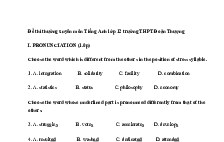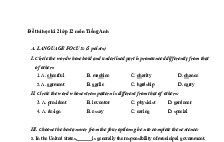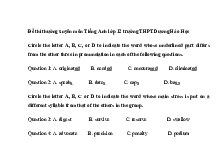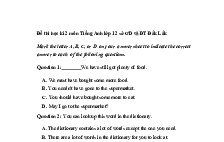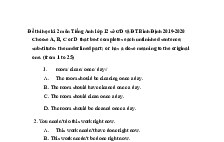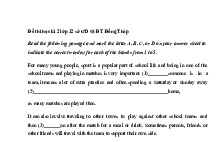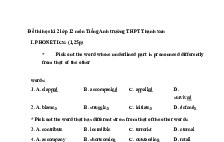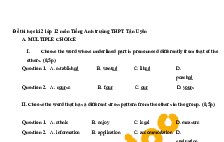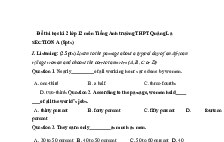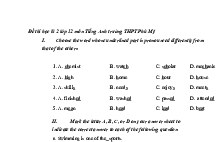Đề thi giữa kì 1 Tiếng Anh 12 trường THCS-THPT Nguyễn Bỉnh Khiêm
Nội dung tài liệu
Tải xuốngCác tài liệu liên quan
-
![Đề thi thường xuyên môn Tiếng Anh lớp 12 trường THPT Đoàn Thượng]()
-
![Đề thi học kì 2 lớp 12 môn Tiếng Anh]()
-
![Đề thi thường xuyên môn Tiếng Anh lớp 12 trường THPT Dương Háo Học]()
-
![Đề thi học kì 2 môn Tiếng Anh lớp 12 sở GD và ĐT Đắk Lắk]()
-
![Đề thi học kì 2 môn Tiếng Anh lớp 12 sở GD và ĐT Bình Định 2019-2020]()
-
![Đề thi học kì 2 lớp 12 sở GD và ĐT Đồng Tháp]()
-
![Đề thi học kì 2 lớp 12 môn Tiếng Anh trường THPT Thanh Sơn]()
-
![Đề thi học kì 2 lớp 12 môn Tiếng Anh trường THPT Tân Uyên]()
-
![Đề thi học kì 2 lớp 12 môn Tiếng Anh trường THPT Quảng La]()
-
![Đề thi học kì 2 lớp 12 môn Tiếng Anh trường THPT Phú Mỹ]()
Có thể bạn quan tâm
Thông tin tài liệu
SỞ GD & ĐT QUẢNG NINH
TRƯỜNG TH – THCS – THPT NGUYỄN BỈNH KHIÊM
Full name:……………………………………………..Class:………….
MÃ ĐỀ 101
| 1. | 2. | 3. | 4. | 5. | 6. | 7. | 8. | 9. | 10. |
|---|---|---|---|---|---|---|---|---|---|
| 11. | 12. | 13. | 14. | 15. | 16. | 17. | 18. | 19. | 20. |
| 21. | 22. | 23. | 24. | 25. | 26. | 27. | 28. | 29. | 30. |
I/ PHẦN TRẮC NGHIỆM
LISTENING
Listen to the recording and decide whether the statements are true (T) or false(F). You will hear the recording twice (1.25pts)
| Question | Content | T | F |
|---|---|---|---|
| 1 | Families in the Western world have changed very much in the last 200 years. | ||
| 2 | Before the 19th century, people usually got married because they were in love. | ||
| 3 | In the 19 century, a marriage joined two families, not Just two people. | ||
| 4 | Later, people realized that education was not necessary for a good life. | ||
| 5 | Today many parents want to have fewer children and take care of their health and give them an education. |
Listen to the recording and choose the best options for each question.You will hear the recording twice: (1.25pts)
Question 6.What does the groom’s family usually do on the wedding day?
A. To receive wedding gifts from guests.
B. To choose the wedding day.
C. To go to the bride’s house bringing a lot of gifts wrapped in red paper.
D. To choose the people who hold the trays of gifts.
Question 7 . What would the groom and the bride usually do during the wedding ceremony?
A. They pray, asking for their ancestors' permission to be married.
B. They stop by each table to say thank to their guests.
C. They hold their wedding banquet.
D. They meet all close relatives, friends and neighbours.
Question 8.When do the groom and the bride exchange their wedding rings?
A. When they receive wedding gifts from guests.
B. After they pray asking for their ancestors’ permission to be married.
C. When they go to the bride’s house with a lot of gifts wrapped in red paper.
D. After the Master of Ceremonies introduces them.
Question 9. What do the groom, the bride and their parents do at the wedding banquet?
A. They stop by each table to say thank to the guests.
B. They exchange their wedding rings.
C. They pray in front of the altar.
D. They give envelopes containing wedding cards and money to the guests.
Question 10. Where is the wedding benquet usually held?
A. The wedding banquet is usually held at the groom's and at a restaurant.
B. The wedding banquet is usually held at bride's home or at a restaurant.
C. The wedding banquet is usually held neither at the groom's and bride's home nor at a restaurant.
D. The wedding banquet is usually held either at the groom's and bride's home or at a restaurant.
LANGUAGE FOCUS
Choose the letter A, B, C, or D to indicate the word whose underlined part differs from the other three in pronunciation.
Question 11 .
| A. rented | B. needed | C. enjoyed | D. polluted |
|---|
Choose the letter A, B, C, or D to indicate the word that differs from the other three in the position of the primary stress.
Question 12 . A. marvelous B. assistant C. maximum D. argument
Choose the letter A, B, C or D to indicate the correct answer to each of the following sentences.
Question 13. Parents are ______by law to send their children to school.
A. obliged B. confided C. demanded D. conducted
Question 14. You can study a lot of interesting _____such as Design & Technology, Architecture, Psychology, Politics at this university.
A. curriculums B. subjects C. schedules D. syllabuses
Question 15.. English students usually ______ their GCSEs at the age of sixteen.
A. pass B. make C. take D. follow
Question 16. Our parents join hands to give us a nice house and a happy home.
A. deal with B. manage C. help together D. work together
Question 17 . In a new culture, many embarrassing situations occur______ a misunderstanding.
A. despite B. because C. because of D. result in
Question 18 When I got home I found that water ___________down the kitchen walls.
A. ran B. was running C. has run D. has been running
READING
Read the following passage and mark the letter A, B, C, or D to indicate the correct word or phrase that best fits each of the numbered blanks.
Children in the Netherlands must be at least four years old to enter primary education. Almost all 4-year-olds (99.3%) in the country indeed (19)__________primary school, although this is not compulsory until children reach the (20) _____ of 5. Primary school is free of charge. In most schools, children are grouped by age in mixed ability classes, with one teacher for all subjects. Primary school (21) _____ of 8 groups, thus schooling lasts for 8 years. During the first two years, which (22) _____ kindergarten, children receive an average of 22 hours of education, during the last 6 years children receive an average of 25 hours per week. Schools are open 5 days a week, but children are(23) _____on Wednesday afternoon. At the end of primary school, or in group 8, schools advice on secondary school choice.
Question 19. A. go B. goes C. going D. to go
Question 20. A. stage B. age C. thought D. feeling
Question 21. A. includes B. contains C. consists D. composes
Question 22. A. also called B. is also calling C. is called also D. is also called
Question 23. A. freedom B. freely C. free D. freeing
Read the following passage and mark the letter A, B, C, or D to indicate the correct answer.
Sometimes people add to what they say even when they don’t talk. Gestures are the “silent language” of every culture. We point a finger or move another part of the div to show what we want to say. It is important to know the div language of every country or we may be misunderstood. In the United States, people greet each other with a handshake in a formal introduction. The handshake must be firm. If the handshake is weak, it is a sign of weakness or unfriendliness. Friends may place a hand on the other’s arm or shoulder. Some people, usually women, greet a friend with a hug.
Space is important to Americans. When two people talk to each other, they usually stand about two and a half feet away and at an angle, so they are not facing each other directly. Americans get uncomfortable when a person stands too close. They will move back to have their space. If Americans touch another person by accident, they say, “Pardon me.” or “Excuse me.” Americans like to look the other person in the eyes when they are talking. If you don’t do so, it means you are bored, hiding something, or are not interested. But when you are stare at someone, it is not polite. For Americans, thumbs-up means yes, very good, or well done. Thumbs down means the opposite. To call a waiter, raise one hand to head level or above. To show you want the check, make a movement with your hands as if you are signing a piece of paper. It is all right to point at things but not at people with the hand and index finger. Americans shake their index finger at children when they scold them and pat them on the head when they admire them. Learning a culture’s div language is sometimes confusing. -If you don’t know what to do, the safest thing to do is to smile.
Question 24.From the passage we can learn that
A.gestures don’t mean anything while talking
gestures can help us to express ourselves
C.American people often use div language in communication
D.It’s confusing to understand a culture’s div language
Question 25.If you are introduced to a stranger from the USA, you should
A.greet him with a hug B. place a hand on his shoulder
C.shake his hand weakly D. shake his hand firmly
Question 26.American people often .
A.show their friendship by touching each other
B.glance at each other when they are talking
C.get uncomfortable when you stand or sit too close to them
D.say “Pardon me.” to each other when they are talking
Question 27. When your friend give you a thumbs-up, he; in fact, _________
A. shows his rudeness to you B. shows his anger to you
C.expresses his worries about you D. expresses his satisfaction to you
Question 28.Which of the following is NOT true about the culture of the United States?
A.Pointing at someone is usually considered rude.
B.It’s rude to stare at the other person.
C.It’s impolite to look the other person in the eyes while talking.
D.It’s all right to raise your hand slightly when you want to attract the waiter’s attention.
Mark the letter A, B, C, or D to indicate the underlined part that needs correction.
Question 29. She has disappeared three days ago , and they are still looking for her now
A B C D
Question 30 What would happen because I pressed that red button ?
A B C D
II/PHẦN TỰ LUẬN.
VOCABULARY
Supply the correct form of word in bracket to fill in the blank to make a meaningful sentence (0.5 points)
Question 31. She is a very_________ woman. She is always helpful and sympathetic toward other people, (care)
Question 32 Whistling to get the person’s attention is usually considered__________ (polite)
WRITING
Rewrite the following sentences, using the given words.
Question 33. "Do you often get up late?" She asked me.
=>She _________________________________________________________________
Question 34 What were you doing at 6 p.m yesterday?" my teacher asked me.
=>My teacher asked me_________________________________________________________________
Question 35. People say that he is intelligent.
=>He is said ______________________________________________________________
Question 36 . During my dinner, the phone rang.
=>While_______________________________________________________________
Write a paragraph to tell about your family. Use the guidelines below. (120 words)
• How many members are there in your family? (the names, ages and jobs).
• How do they share the housework?
• How do they behave?
• What are their hobbies?
• What do you like about each of them?
………………………………………………………………………………………………………………………………………………………………………………………………………………………………………………………………………………………………………………………………………………………
………………………………………………………………………………………………………………………………………………………………………………………………………………………………………………………………………………………………………………………………………………………
………………………………………………………………………………………………………………………………………………………………………………………………………………………………………………………………………………………………………………………………………………………
………………………………………………………………………………………………………………………………………………………………………………………………………………………………………………………………………………………………………………………………………………………
………………………………………………………………………………………………………………………………………………………………………………………………………………………………………………………………………………………………………………………………………………………
………………………………………………………………………………………………………………………………………………………………………………………………………………………………………………………………………………………………………………………………………………………
………………………………………………………………………………………………………………………………………………………………………………………………………………………………………………………………………………………………………………………………………………………
………………………………………………………………………………………………………………………………………………………………………………………………………………………………………………………………………………………………………………………………………………………
………………………………………………………………………………………………………………………………………………………………………………………………………………………………………………………………………………………………………………………………………………………
The end


